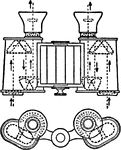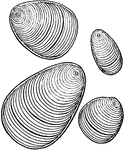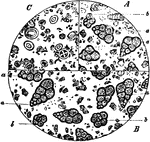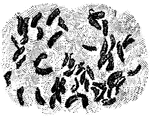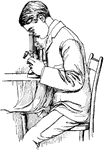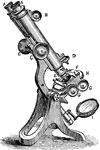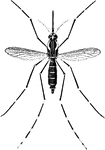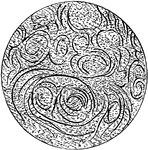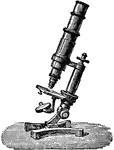Clipart tagged: ‘microscope’
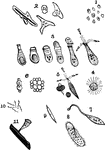
Forms of the animalcules, magnified
"Fig. 1, Monads; 2, Forms assumed by the Ameoba; 3, Flask Animalcules, Enchelis; 4, Actinophrys sol;…
Micrographic Apparatus with Camera and Microscope
An apparatus used to photograph images in a light microscope. The long camera is connected to the eye…

Bacilli
"Bacilli, or Rod-Shaped Bacteria. From a culture obtained in antharax, or malignant pustule, of the…
bacteria and cambric needle
The point of the finest cambric needle, with a particle of dust (above) and bacteria (below) for scale.
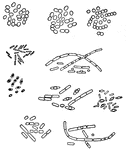
Milk bacteria
"Different Kinds of Milk Bacteria. It is not uncommon for a large number of person to be poisoned from…

Binocular Telescope
Binocular telescopes, or binoculars (also known as field glasses), are two identical or mirror-symmetrical…
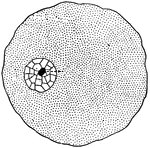
Cell
"In a general what we may describe a cell as a tiny mass of jelly in which floats another still smaller…

Various forms of cells
"A, columnar cells found lining various parts of the intestines (called columnar epthelium);…
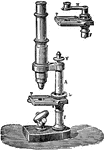
Compound Microscope
"Nachet's Combined Simple and Compound Microscope." —The Encyclopedia Britannica, 1903

Compound Microscope
"Ross's Jackson-Zentmayer Compound Microscope." —The Encyclopedia Britannica, 1903

Hair with ringworm
"A Piece of Hair from the Scalp infested with a Mold which produces Ringworm. Ringworm may occur anywhere…
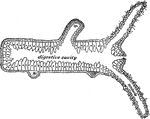
Section of a hydra
"Longitudinal section of a Hydra; b, bud which will form a young one; ba, base by…
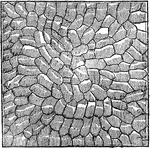
Microscopic view of a leaf
"The branch vascular bundles will be distinctly seen, resembling in some respects the arteries and veins…

Huyegenian Eyepiece Diagram Showing Lens Refraction
"They have also a shorter focus for red, and a longer one for blue, and thus magnify the red image more…

Ramsden Eyepiece Lens Refraction Diagram
"If the real image produced by the objective coincides with the collective lens, only the inclination…
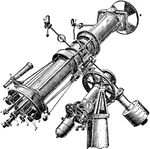
Micrometer
"The circles for position angle and declination are read by micrometer microscopes illuminated by the…

Microscope
"A microscope consists of a lens or a combination of lenses used to observe small objects, often so…
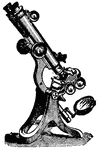
Microscope
An optical instrument designed to eamine minute objects or parts of objects, and which so magnifies…

Microscope
"For a laboratory microscope, the pattern represented here has been found very convienient, —the…

Baker Demonstration Light Microscope with Mirror Reflecting Light Source
A Baker demonstration light microscope illustrating the different parts of the microscope. The eyepiece…

Swift Stephen's Binocular Microscope with Mirror Reflecting Light Source
A swift Stephenson's Binocular Microscope with a mirror reflecting light source. The microscope has…

Compound microscope
"A Compound Microscope. The appearance of the various structures and tissues of the human body as revealed…

Compound Microscope
"This consists of two convex lenses, by one of which the image is formed within the tube of the instrument,…

Entocentric Transmission in Compound Microscope Appear Images Larger or Smaller
An illustration of entocentric transmission of a compound microscope. The series of light refracted…
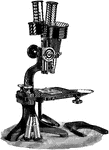
Greenough's Binocular Light Compound Microscope with Mirror Reflecting Light Source
A Greenough's binocular light microscope. The microscope has two eyepieces to view the sample with both…

Hypercentric Transmission in Microscopic Objective
"The intersection of the principal rays lies in front of the object, and consequently objects in front…

Petrographical Microscope
An illustration of a petrographical microscope. A petrographic microscope is a type of optical microscope…

Petrographical Light Microscope with Mirror and Eyepieces
A petrographic light microscope used to identify thin layered rocks and minerals. The microscope have…
Ray Transmission in Compound Microscope with a Positive Ocular
"The image produced by a microscope formed of two positive systems is inverted, the objective L1 tracing…
Ray Transmission in Compound Microscope with a Negative Eyepiece
An illustration of a compound microscope that produces upright image using negative eyepiece. The image…

Solar Microscope
"This consists of two lenses, one of which is called the condesner, because it is employed to concentrate…

Microscope Mirror Illumination by Light Reflection
A light reflection diagram of a light microscope using a mirror. The mirror is used in a microscope…

Abbe Microscope Mirror Illumination by Light Reflection with Condenser
Illustration showing Abbe illuminating apparatus with condenser. The mirror, m, reflects light from…
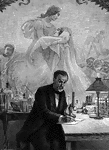
Louis Pasteur
"This picture is based upon a photograph of a painting which has won great fame during recent years.…

Polariscope
An optical instrument, various forms of which have been contrived for exhibiting the polarization of…

Portable Microscope
"Nachet's Portable Compound and Dissecting Microscope, as packed in case." —The Encyclopedia Britannica,…
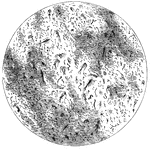
Protozoans
"Their bodies consist either of aa simple elementary cell, with its contents, or of an aggregation of…
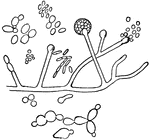
Fermentation of wine
"Organisms found upon the Skin o a Grape and concerned in the Fermentation of Wine." — Blaisedell,…
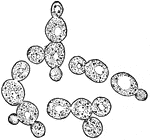
Yeast cells
"Yeast Cells, found in the Juice of Apples, which cause the fermentation of Cider." — Blaisedell,…


